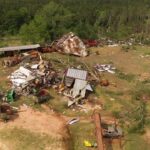
By Ronald Thomas, Editor, The Orator
I am seeking a champion: A Joan of Arc, a Jack the Giant Killer, a David, a Luke Skywalker, a little old lady with a mean umbrella – it doesn’t matter. I am seeking someone with the time and perseverance to adopt a particular cause and see it through to the end. I am seeking someone who can become indignant, righteously or otherwise, about a matter and stay that way until the fight is finished. I need a champion because I have a cause, but I don’t have the time or energy to defend the cause adequately myself.
The problem is all about dirt. There is some for sale just east of Abbeville on Alabama Highway 10. Quite a bit seems to have been bought and hauled away already, but there is plenty more to be had. This particular dirt is nothing special except that it is full of the bones of somebody’s ancestors! A burial ground is being desecrated in full view of the community and nobody can or will do anything about it. Where, O where, is my champion?
Nearly two years ago, a local contractor began to take dirt from the site for a highway widening and resurfacing project. When human bones showed up, the contractor immediately stopped excavating. Credit goes to this company for refusing to participate in the further desecration of a cemetery, and finding their dirt elsewhere.
There was a flurry of excitement in the community and local media about the discovery of an unknown burial ground. Troy University sent some kind of specialist to investigate the site and take possession of the remains. Local law enforcement put up some yellow plastic tape. The Alabama Historical Commission assigned a staff person to oversee the investigation. Speculation flew as to who the bones belonged.
Three, or maybe four, possibilities emerged: (1) it was the Pippin family cemetery; (2) it was a slave or former slave cemetery; (3) it was a native American burial ground; or (4) it was a dirt pit that needed to be swapped for some pieces of silver. The Pippin cemetery was soon located about 200 yards away to the east, and eliminated from the list. The slave cemetery is supposedly northeast of the Pippin cemetery, but it hasn’t been located yet, and remains a contended for the “unknown” or “nonexistent” cemetery that is being dug up. That leaves the field either to native Americans, slaves or somebody with dirt to sell.
For a few months it seemed that a link to Henry County’s history, perhaps even pre-Columbia, had been discovered and might be preserved with little damage. A local law enforcement agent, on his own time, tried to locate and count the individual graves. Troy University was said to be determining the age of the artifacts. HCHG”s own Larry Smith was taken to the site to discuss protection and preservation. The Alabama Historical Commission was citing laws that forbade further disturbance of the site, and promising to assist everyone in preserving the burial ground. Then it all disintegrated.
Garnet Garvin, the Alabama Historical Commission’s representative was tragically killed in an automobile accident. The police officer who had been keeping the issue on the front burner was told to stay off private property. Troy University fell ominously silent. And the dirt – and the bones – began to be hauled away again. It appeared that money had talked.
So come, my champion! Take up this cause before it is too late. Take it up even if it IS too late. Take it up even if it is futile. Take it up because the cause is noble and right. I have a notion that if the right persons in the native American or African American communities could be contacted, that something positive might result. I have a notion that the influence of local money or influence might be overcome, and that the willful and wanton desecration of graves not be permitted to continue.



